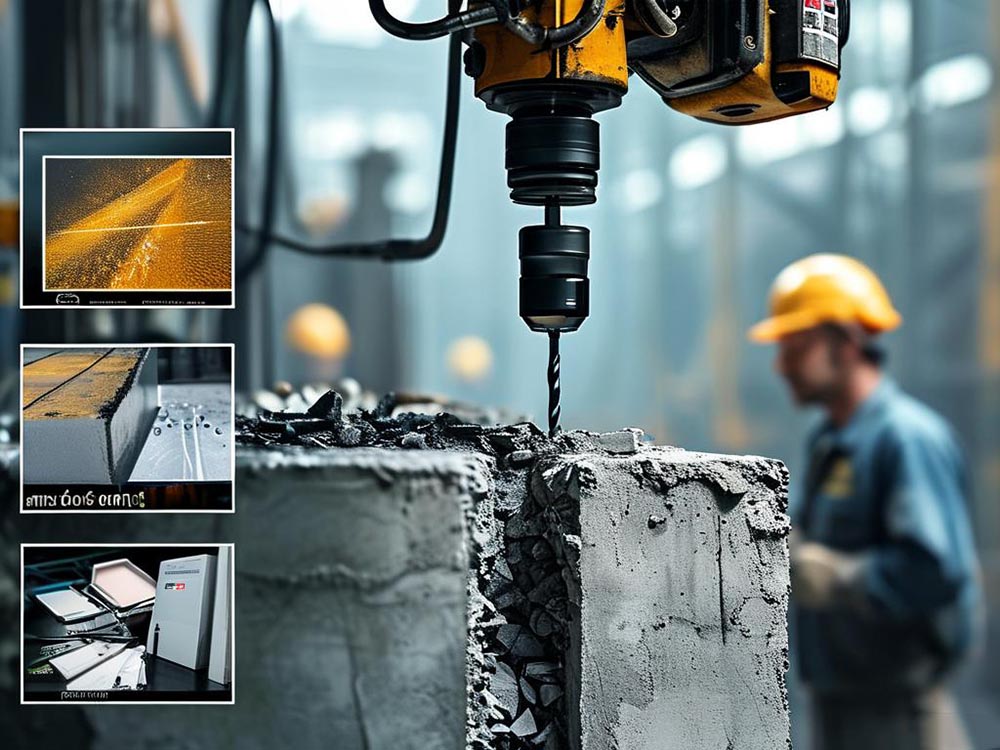“Those ‘Invincible Drill Bits’ in Movies Wouldn’t Last Three Seconds in Real Life!”
When heroes on screen wield power drills that effortlessly pierce through reinforced concrete walls, audiences often marvel at the seemingly omnipotent tool. But in the real world of industrial manufacturing, scenes like these make materials engineers collectively cringe—for every spinning drill bit is engaged in a fierce showdown with material strength, energy conversion, and the laws of thermodynamics. From quartz grains embedded in concrete to microscopic lattice fractures during metal cutting, real-life drilling is far from a simple act of "rotate and press." While cinematic effects blur physical limits, the industrial world quietly pushes the true boundaries of tool performance using nanocoatings and micro-Newton mechanical control.
Scene 1: The Concrete Penetration Myth
The Physics Problem Behind Prison Break-Style Wall Drilling
In films, drilling through a load-bearing wall in 30 seconds may look dramatic, but it violates at least three basic principles:
- Law of Torque Conservation:
A standard 18V power drill delivers a maximum torque of ~60 N·m. In contrast, a Φ12 mm concrete drill bit requires at least 120 N·m to penetrate reinforced concrete.
- Energy Conversion Formula:
Using Q=cmΔTQ=cmΔT, over 90% of mechanical energy converts into heat during concrete drilling.
- Wear Equation:
WC-Co (tungsten carbide) drill bits wear at 0.3 mm/min at 600°C.
Our Custom Diamond Core Drill for Subway Projects:
- Honeycomb matrix cutting head: 1,200 synthetic diamond particles (40–50 mesh) embedded per cm²
- Segmented chip evacuation grooves: Expels 3.2 g of debris every 20° of rotation
- Dual-layer water cooling system: Circulates 4 L/min to keep bit temperature ≤ 80°C
Scene 2: The Micro-Drill Paradox
The Size Curse Behind Spy Gadgets
When James Bond uses a pen-sized drill to cut through 20 mm of steel, one critical parameter is ignored: the length-to-diameter ratio limit.
- A Φ0.5 mm carbide drill has a maximum effective cutting depth of 8 mm (L/D = 16:1)
- Every 0.1 mm decrease in diameter causes exponential cost increases (see chart)
Our Micro-Drilling Solution for Swiss Precision Instruments:
- Ultrasonic-assisted cutting: 3 μm amplitude, 28 kHz frequency
- Custom nano-coating: 2 μm AlCrN coating increases tool life by 300%
- Constant-pressure feed system: Pressure control at 0.05 N prevents breakage
Scene 3: The Tapping Misconception
The Mechanical Truth About Action-Movie Thread Cutting
In Mission Impossible, tapping into a wall to "unscrew" your way through confuses two fundamentally different mechanical properties:
| Tensile Strength (MPa) | Flexural Strength (MPa) |
|---|
| Standard HSS Tap | 2100 | 480 |
| Carbide Tap | 3400 | 720 |
Our ASP2053 Powder Metallurgy Tap for Aerospace Fasteners:
- S-helix design: 38° lead angle optimizes chip flow
- TiAlN composite coating: Surface hardness reaches 3200 HV
- Flexural-strengthened core: Core hardness of 52 HRC transitions to 62 HRC at the surface
The Hidden Dialogue Between Cinema and Manufacturing
- The Death of Spark Effects:
- 1990s: Real sparks using standard HSS bits during filming
- Post-2020: Switched to our CBN cutting tools + CGI (friction coefficient as low as 0.1)
- Dual Standards in Sound Design:
- Real drilling produces high-pitched tones in the 2–8 kHz range (most irritating to human ears)
- Movie soundtracks emphasize 100–500 Hz bass for "tactile impact"
- The Prop Maker’s Ultimate Challenge:
- Movie "magic drills" often feature a tungsten steel core with a foam plastic casing
- Drill tip includes a micro pyrotechnic charge for dramatic effect (~$150 per use)
Breakthroughs from the Manufacturing Frontline
- Mars Drill Project:
- Gradient Function Material (FGM) drills worked 214 continuous hours under simulated Martian conditions (−95°C to +150°C cycles).
- Dust abrasion rate was only 17% of Earth-standard levels.
- Biocompatible Taps:
- Zirconia ceramic coatings comply with ISO 10993 medical standards
- Achieved zero metal contamination during titanium orthopedic implant threading
Professional Advice for Film Directors:
Want to shoot a truly breathtaking drilling scene? Try these:
- Use our deep-hole drill (Φ3 mm × 300 mm) for slow-motion, microscope-level footage
- Apply thermochromic coating on the drill tip—visually track temperature rise with color shifts
- Film with a maglev drilling rig to capture vibration-free ultra-clean cuts
Conclusion:
Those “supernatural” drill scenes in films are, in truth, material science silently protesting artistic liberty. Whether it’s the length-to-diameter curse of micro-drills or the flexural limits of taps, they remind us that every industrial breakthrough is a carefully negotiated truce between energy conservation and material thresholds. While movies dazzle with pyrotechnics and CGI, real technological advances are unfolding under electron microscopes in coating labs or within the computations of cutting simulation software. Perhaps the truest “black tech” has never been about defying physical laws—but mastering them with human ingenuity.



 We like to do design according to all the customers' requirements, or offer them our new designs. With strong OEM/ODM capabilities, we can fill your sourcing demands.
We like to do design according to all the customers' requirements, or offer them our new designs. With strong OEM/ODM capabilities, we can fill your sourcing demands.